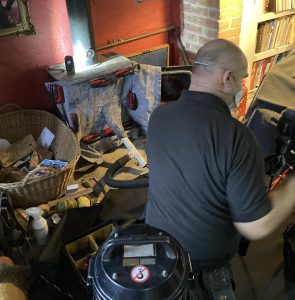 Here is a salutary tale from Thaxted this week about the need to have a chimney regularly swept – A barn conversion caught fire and lost most of its roof when soot deposits in the chimney caught fire and spread to the loft space. The soot had apparently collected in the top part of the chimney as the chimney had not been swept for some time. People don’t realise that if a chimney catches fire and the have not had it swept annually by a reputable trades person and they therefore have not been issued with an annual Safety Certificate, then the insurance company is unlikely to pay out for any damage caused.
Here is a salutary tale from Thaxted this week about the need to have a chimney regularly swept – A barn conversion caught fire and lost most of its roof when soot deposits in the chimney caught fire and spread to the loft space. The soot had apparently collected in the top part of the chimney as the chimney had not been swept for some time. People don’t realise that if a chimney catches fire and the have not had it swept annually by a reputable trades person and they therefore have not been issued with an annual Safety Certificate, then the insurance company is unlikely to pay out for any damage caused.
Essex Fire Brigade report:
Firefighters are reminding residents to check and clean their chimneys regularly after a fire caused significant damage to a timber-framed home in Thaxted this evening (Wednesday 11 December).
Crews from Thaxted, Saffron Walden, Newport and Braintree, along with an Aerial Ladder Platform from Chelmsford, were called to the property at 5:20pm after the homeowners noticed part of the interior wall had collapsed, revealing a fire inside the chimney.
The fire, which was caused by a build up of soot and debris in the chimney, quickly spread through the loft space and roof due to the timber-framed structure of the house.
Firefighters wearing breathing apparatus worked to tackle the fire from inside the home, while crews on the Aerial Ladder Platform extinguished the flames from above. Thanks to their efforts, they successfully contained the fire and prevented further spread.
Station Manager Kev Jenner said:
“Our crews worked incredibly hard in challenging conditions to stop the fire from spreading further through the property. Thankfully, the family escaped without injury, but the roof has been significantly damaged, and there is smoke and water damage throughout the home.
“This incident highlights the importance of regularly maintaining and cleaning your chimney, especially in older, timber-framed properties, where fire can spread rapidly.”
The fire was fully extinguished by 8:15pm, but crews will remain at the scene into the night to monitor for hotspots and make sure the area is safe.
Chimney Safety Advice
To reduce the risk of chimney fires, follow these tips:
- Have your chimney swept at least once a year, or more frequently if you burn wood.
- Avoid burning resinous woods; use only suitable seasoned timber in solid fuel stoves.
- Do not stack fires too high and allow them to burn down well before you go to bed.
- Use a fire or spark guard to prevent embers from escaping.
- Inspect your chimney regularly—particularly in the roof space—to check for cracks or broken bricks.
For more safety tips, visit essex-fire.gov.uk/chimney.


 My name is Paddy McKeown, I am a retired police officer (Detective Sergeant – Metropolitan Police), turned chimney sweep. I have completed training with ‘The Guild of Master Chimney Sweeps’, and Rod Tech UK (Power Sweeping).
My name is Paddy McKeown, I am a retired police officer (Detective Sergeant – Metropolitan Police), turned chimney sweep. I have completed training with ‘The Guild of Master Chimney Sweeps’, and Rod Tech UK (Power Sweeping).

 In the churchyard there is a memorial to murdered policeman Sergeant Eves – Acting Sergeant 63 Adam Eves was posted to Purleigh in January 1891 where he lived in a cottage with his wife Elizabeth. He was popular with his residents although of course he made a number of enemies amongst the criminal classes and had been threatened with violence often in the course of his duties. Sergeant Eves was on night patrol on Saturday 15 April 1893 after which he failed to return home. During the afternoon of the following day his body was discovered in a ditch at nearby Hazeleigh Hall Farm. His body was badly mutilated, and his throat had been slashed. While Detectives investigated the murder of Sergeant Eves other Officers were investigating the theft of 13 bushels of corn from a nearby barn. Enquiries took police to the home of a local petty criminals, Richard and John Davis. There they found a handcart which contained traces of blood and corn. Three further sacks of corn were found in their garden. Charles Sales and John Batemen who were friends of the Davis brothers were also arrested. Clothes from Sales, Batemen and Richard Davis were all found to be stained with blood. Further arrests of James Ramsey and his son John were made shortly afterwards.
In the churchyard there is a memorial to murdered policeman Sergeant Eves – Acting Sergeant 63 Adam Eves was posted to Purleigh in January 1891 where he lived in a cottage with his wife Elizabeth. He was popular with his residents although of course he made a number of enemies amongst the criminal classes and had been threatened with violence often in the course of his duties. Sergeant Eves was on night patrol on Saturday 15 April 1893 after which he failed to return home. During the afternoon of the following day his body was discovered in a ditch at nearby Hazeleigh Hall Farm. His body was badly mutilated, and his throat had been slashed. While Detectives investigated the murder of Sergeant Eves other Officers were investigating the theft of 13 bushels of corn from a nearby barn. Enquiries took police to the home of a local petty criminals, Richard and John Davis. There they found a handcart which contained traces of blood and corn. Three further sacks of corn were found in their garden. Charles Sales and John Batemen who were friends of the Davis brothers were also arrested. Clothes from Sales, Batemen and Richard Davis were all found to be stained with blood. Further arrests of James Ramsey and his son John were made shortly afterwards.


 I thought for this week’s blog I would write another one about us working. On this occasion I have chosen one of our regular biannual jobs at a thatched cottage in Radwinter. Here we are sweeping a Stovax Stockton boiler stove. By their very nature and construction, boiler stoves have a tendency to tick-over and therefore create a large quantity of crusty tar in the chimney – A job for rotary power sweeping. Rotary power sweeping being the most effective sweeping method for removing resistant tar from the chimney.
I thought for this week’s blog I would write another one about us working. On this occasion I have chosen one of our regular biannual jobs at a thatched cottage in Radwinter. Here we are sweeping a Stovax Stockton boiler stove. By their very nature and construction, boiler stoves have a tendency to tick-over and therefore create a large quantity of crusty tar in the chimney – A job for rotary power sweeping. Rotary power sweeping being the most effective sweeping method for removing resistant tar from the chimney.





 Here is a real oddity, I recently came across this stove in Radwinter and really didn’t know what to make of it, I’ve never seen one quite like it before. I don’t know if any of the readers of this blog have seen a stove like this one before and might know what the make and model is? The customer told me that it is a Norwegian make of stove, but it is so long since he bought it and had it installed, he could not remember the name of the make and model and no longer has any paperwork for it. He did say that they have lived in their property for a very long time and that the stove was installed many, many years ago. The only stove manufacturers that I know that are Norwegian are; Jotul, Nordpeise, Kernow and Rais, none of which make a stove that looks like this one and it is difficult to find out if they ever did. On the plus side the customer says that the stove works exceedingly well and that when it is burning, it heats the whole of the downstairs of the house. Excellent!
Here is a real oddity, I recently came across this stove in Radwinter and really didn’t know what to make of it, I’ve never seen one quite like it before. I don’t know if any of the readers of this blog have seen a stove like this one before and might know what the make and model is? The customer told me that it is a Norwegian make of stove, but it is so long since he bought it and had it installed, he could not remember the name of the make and model and no longer has any paperwork for it. He did say that they have lived in their property for a very long time and that the stove was installed many, many years ago. The only stove manufacturers that I know that are Norwegian are; Jotul, Nordpeise, Kernow and Rais, none of which make a stove that looks like this one and it is difficult to find out if they ever did. On the plus side the customer says that the stove works exceedingly well and that when it is burning, it heats the whole of the downstairs of the house. Excellent!



